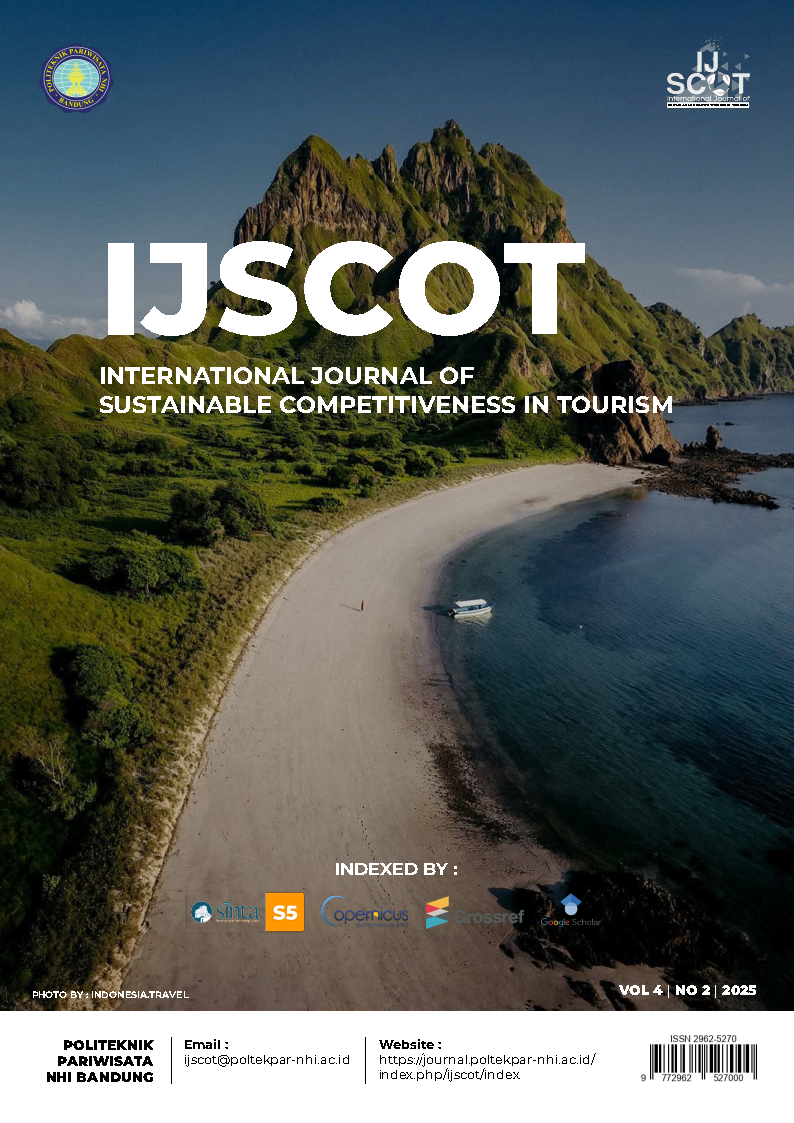The Role of the Physical Environment in the Development of Tourism Villages in Indonesia: a Case Study of Geotourism Development in Alamendah and Limbasari Villages
Abstract
This paper explores the critical role of physical geological environments in driving geotourism-based village tourism development in Indonesia, with case studies from Tourism Villages of Alamendah in Bandung and Limbasari in Purbalingga. Using a literature review method with a descriptive-analytical approach, the study highlights how unique geological features, combined with active community participation, contribute to sustainable tourism development. Indonesia, as a megadiverse country, possesses extraordinary geological potential, including volcanic landscapes, geomorphological formations, and mineralogical diversity, offering significant opportunities for geotourism. These natural assets not only enhance the aesthetic and educational value of tourism destinations but also support environmental conservation and local economic empowerment. Desa Wisata Alamendah exemplifies successful integration of geological potential with local economic activities, particularly through agritourism and digital innovation in tourism management. With monthly revenues reaching Rp1.3 billion, the village serves as a model for sustainable tourism. Meanwhile, Desa Limbasari leverages its geological sites, such as pillow lava and green jasper, to attract tourists, significantly benefiting residents. Despite their successes, both villages face challenges, including limited infrastructure, accessibility issues, and the need for greater community engagement. Geotourism aligns with the United Nations' Sustainable Development Goals (SDGs) by addressing poverty reduction, quality education, gender equality, decent work, climate action, and ecosystem preservation. To ensure sustainability, the study recommends strategies encompassing geoheritage certification, improved accessibility, technological adoption for interpretative purposes, and enhanced community participation. The research concludes that the physical environment plays a pivotal role in geotourism development, serving as both an attraction for tourists and a foundation for inclusive, environmentally-friendly local economic growth. By fostering collaboration among governments, tourism stakeholders, and local communities, Indonesia can harness its geological wealth to drive sustainable rural development while preserving its natural and cultural heritage.
References
Aldiansyah. (2023). Potret Desa Wisata Alamendah yang punya omset miliaran rupiah . Travel Detik. https://travel.detik.com/fototravel/d-6992049/potret-desa-wisata-alamendahyang-punya-omset-miliaran-rupiah
Dowling, R.K. & Newsome, D. 2006. Geotourism. Elsevier, Oxford.
Dowling, R. K. 2009. The growth of global geotourism. Proceedings of the VIII European Geoparks Conference, 24–30.
Dowling, R. K. 2011. Geotourism’s Global Growth.Geoheritage (3rd ed.).
Fasa, A. W. H., & Berliandaldo, M. (2022). Pengelolaan Geowisata Berkelanjutan Dalam Mendukung Pelestarian Warisan Geologi: Perspektif Collaborative Governance. Inovasi: Jurnal Politik Dan Kebijakan, 19(1).
Gibran, A. K., Sunan, H. L., & Purnomo, W. H. (2019). Upaya Pengembagan Potensi Desa Wisata Limbasari Purbalingga Berbasis Edukasi Dan Kelestarian Alam. Prosiding Seminar Nasional Dan Call For Papers ”Pengembangan Sumber Daya Perdesaan Dan Kearifan Lokal Berkelanjutan Ix. Https://Maps.Google.Com/
Hermawan, H., & Ghani, Y. A. (2018). Geowisata : Solusi Pemanfaatan Kekayaan Geologi Yang Berwawasan Lingkungan. In Jurnal Sains Terapan Pariwisata (Vol. 3, Issue 3).
Indrayati, A., Dosen, W. S., Geografi, J., & Artikel, S. (2017). Jurnal Geografi Media Pengembangan Ilmu Dan Profesi Kegeografian Mengungkap Potensi Kabupaten Rembang Sebagai Geowisata Dan Laboratorium Lapangan Geografi (Vol. 14, Issue 1). Http://Journal.Unnes.Ac.Id/Sju/Index.Php/Ujet
Khalid, S., Ahmad, M. S., Ramayah, T., Hwang, J., & Kim, I. (2019). Community Empowerment And Sustainable Tourism Development: The Mediating Role Of Community Support For Tourism. Sustainability (Switzerland), 11(22). Https://Doi.Org/10.3390/Su11226248
Pardede, T. 2021. Geopark Jalan Eklektik Pembangunan Berkelanjutan Di Masa Pandemi COVID19.
Pedrason, R. (2021). Indo-Pasifik Dalam Perspektif Geopolitik Dan Geostrategi. Jppi (Jurnal Penelitian Pendidikan Indonesia), 7(1), 88–95. Https://Doi.Org/10.29210/02021830
Prakoso, A. A., Pradipto, E., Roychansyah, M. S., & Nugraha, B. S. (2020). Community-Based Tourism: Concepts, Opportunities And Challenges. Journal Of Sustainable Tourism And Entrepreneurship, 2(2), 95–107. Https://Doi.Org/10.35912/Joste.V2i2.563
Sunan, H. L., Purnomo, W. H., Chasanah, N., Sugiyanto, G., Adhiana, T. P., Susilawati, H., Imran, R. A., Gibran, A. K., Suroso, S., Cahyono, T., & Laksono, F. A. T. (2020). Kelayakan Geosite Dan Geomorphosite Kawasan Desa Wisata Limbasari Sebagai Potensi Geowisata Desa Limbasari. Indonesian Journal Of Community Services, 2(2), 109. Https://Doi.Org/10.30659/Ijocs.2.2.109-117
UNWTO. (2021). Tourism and the Sustainable Development Goals – Journey to 2030. World Tourism Organization . https://www.unwto.org
Authors

This work is licensed under a Creative Commons Attribution-ShareAlike 4.0 International License.

